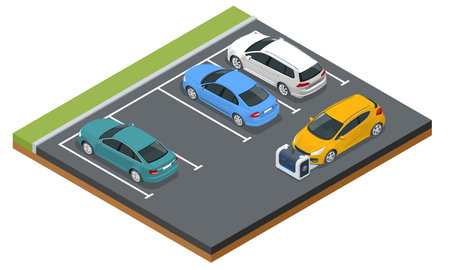1. Advancements in Battery Technology
One of the most critical factors driving the future of electric vehicles (EVs) is battery technology. As automakers and researchers work on improving battery efficiency, energy density, and charging speed, we are seeing rapid advancements that will shape the EV industry in the coming years.
Improving Battery Efficiency
Battery efficiency determines how effectively an EV can use stored energy for driving. With advancements in energy management systems and smarter battery controls, modern EVs are becoming more efficient, allowing them to travel longer distances on a single charge.
Higher Energy Density Batteries
Energy density refers to how much energy a battery can store relative to its weight or size. New battery chemistries, such as solid-state batteries and lithium-silicon technology, are expected to significantly increase energy density. This means EVs will have lighter and more powerful batteries, leading to longer ranges and improved performance.
| Battery Type | Energy Density (Wh/kg) | Expected Benefits |
|---|---|---|
| Lithium-Ion | 250-300 | Current standard, widely used in EVs |
| Solid-State | 400-500 | Higher energy storage, better safety |
| Lithium-Silicon | 500+ | Increased range, faster charging |
Faster Charging Speeds
Charging speed is a major concern for EV owners. New battery materials and improved charging infrastructure are drastically reducing charging times. Ultra-fast chargers, combined with better battery cooling technologies, allow for charging from 10% to 80% in under 20 minutes. Companies are also working on wireless charging solutions that could make refueling EVs even more convenient.
The Role of Ultra-Fast Charging
Ultra-fast chargers, such as 350kW DC fast chargers, enable EVs to gain hundreds of miles of range in minutes. This development helps overcome range anxiety and makes EVs more practical for long-distance travel.
Looking Ahead
With continuous innovation in battery technology, the next decade will bring more affordable, efficient, and high-performance EVs. As researchers push the boundaries of battery capabilities, we can expect electric vehicles to become an even more viable alternative to traditional gasoline-powered cars.
2. Expanding EV Infrastructure
One of the biggest factors driving the future of electric vehicles (EVs) is the expansion of charging infrastructure. As more people switch to EVs, there is a growing need for a reliable, fast, and widely available charging network.
Growth of Charging Networks
EV charging networks are rapidly expanding across the U.S. Companies like Tesla, Electrify America, and ChargePoint are increasing the number of charging stations to meet the rising demand. Here’s a look at the key types of charging stations:
| Charging Level | Charging Speed | Best For |
|---|---|---|
| Level 1 | 2-5 miles per hour | Home charging |
| Level 2 | 10-60 miles per hour | Public and home charging |
| DC Fast Charging | 60-250+ miles in 30 minutes | Highway and urban fast charging |
Smart Grid Integration
To improve efficiency and sustainability, EV charging is being integrated with smart grids. Smart grids help balance electricity demand, reduce costs, and use renewable energy sources more effectively. Features like vehicle-to-grid (V2G) technology allow EVs to send electricity back to the grid when needed, benefiting both drivers and the power grid.
Benefits of Smart Grid Integration
- More efficient energy distribution
- Lower charging costs during off-peak hours
- Increased use of renewable energy
The Role of Government Policies
Government support is crucial for the expansion of EV infrastructure. Many federal and state programs offer incentives to build more charging stations, promote the use of EVs, and encourage research into better battery technology. Some key initiatives include:
Federal and State Incentives
- Tax credits and rebates for EV buyers
- Funding for public charging stations
- Investment in renewable energy integration
With a growing charging network, smart grid improvements, and strong government support, the EV infrastructure landscape is evolving rapidly to make electric vehicles more accessible and practical for everyone.

3. Three, The Rise of Autonomous and Connected EVs
Self-driving technology and vehicle-to-everything (V2X) communication are transforming the electric vehicle (EV) industry. These innovations promise to enhance safety, reduce traffic congestion, and improve energy efficiency. As advancements continue, autonomous and connected EVs will play a crucial role in shaping the future of transportation.
How Self-Driving Technology Impacts EVs
Autonomous driving technology is becoming more sophisticated, with companies like Tesla, Waymo, and General Motors investing heavily in self-driving systems. These technologies rely on AI, sensors, and real-time data to navigate roads safely without human input.
Key Benefits of Self-Driving EVs
| Benefit | Impact |
|---|---|
| Reduced Accidents | AI-driven systems minimize human errors, making roads safer. |
| Efficient Traffic Flow | Autonomous vehicles communicate with each other to reduce congestion. |
| Energy Savings | Optimized driving patterns lower EVs energy consumption. |
| Increased Accessibility | Self-driving cars enable mobility for people unable to drive. |
Understanding V2X Communication
Vehicle-to-everything (V2X) technology allows EVs to communicate with surrounding infrastructure, other vehicles, pedestrians, and traffic signals. This connectivity improves road safety and enhances overall driving efficiency.
Types of V2X Communication
- Vehicle-to-Vehicle (V2V): EVs share speed, location, and direction data to prevent collisions.
- Vehicle-to-Infrastructure (V2I): EVs interact with traffic signals, road signs, and smart city systems.
- Vehicle-to-Pedestrian (V2P): Sensors detect pedestrians and cyclists, reducing the risk of accidents.
- Vehicle-to-Network (V2N): EVs receive real-time traffic updates and weather conditions from cloud networks.
Challenges and Future Considerations
Despite the benefits, widespread adoption of autonomous and connected EVs faces several challenges. Issues like cybersecurity risks, regulatory approvals, and public trust must be addressed before full-scale implementation. However, as technology advances and infrastructure improves, these hurdles are expected to be overcome.
4. Sustainability and Environmental Impact
As electric vehicles (EVs) become more widespread, their impact on sustainability and the environment is a major focus. The shift from gasoline-powered cars to EVs significantly reduces greenhouse gas emissions, but the production process and battery recycling also play crucial roles in minimizing carbon footprints. Advances in these areas are shaping the future of EV sustainability.
How EV Production Is Becoming Greener
Manufacturing EVs requires energy and raw materials, including lithium, cobalt, and nickel for batteries. However, automakers are adopting more eco-friendly production methods to reduce emissions and resource consumption. Some key advancements include:
- Using renewable energy in factories to lower carbon emissions
- Developing battery chemistries that require fewer scarce materials
- Recycling materials from old batteries to create new ones
- Improving energy efficiency in vehicle production
Battery Recycling and Its Role in Sustainability
The increase in EV adoption means more batteries will eventually reach the end of their lifespan. Proper recycling not only reduces waste but also decreases the need for newly mined materials. Companies and researchers are working on innovative solutions such as:
- Recovering valuable metals like lithium and cobalt for reuse
- Creating second-life applications, such as using old batteries for energy storage
- Improving recycling processes to increase efficiency and reduce environmental impact
Comparing Traditional and Sustainable EV Production
The differences between traditional EV production and newer, more sustainable approaches can be seen in the following comparison:
| Aspect | Traditional EV Production | Sustainable EV Production |
|---|---|---|
| Energy Source | Primarily fossil fuels | Increased use of renewable energy |
| Battery Materials | Heavy reliance on newly mined materials | More recycled and alternative materials |
| Manufacturing Efficiency | High emissions and energy use | Eco-friendly processes and higher efficiency |
| Battery End-of-Life Management | Limited recycling efforts | Advanced recycling and second-life applications |
Future Innovations in Sustainable EVs
As technology advances, the sustainability of EVs will continue to improve. Researchers are working on solid-state batteries, which require fewer raw materials and last longer than current lithium-ion batteries. Additionally, automakers are exploring ways to make vehicle production even greener by utilizing biodegradable materials and closed-loop recycling systems to minimize waste.
5. Market Trends and Consumer Adoption
The electric vehicle (EV) market is evolving rapidly, influenced by various factors shaping consumer adoption and industry competition. Understanding key trends in consumer preferences, pricing dynamics, and market competition is essential for predicting the future of EVs.
Key Factors Influencing Consumer Preferences
Customers consider several factors when choosing an EV over a traditional gasoline-powered vehicle. These include battery range, charging infrastructure, price, brand reputation, and government incentives.
Top Consumer Priorities When Buying an EV
| Factor | Importance |
|---|---|
| Battery Range | High – Consumers want EVs that can travel long distances on a single charge. |
| Charging Infrastructure | High – The availability of charging stations significantly affects buying decisions. |
| Price & Incentives | Medium – Buyers look for competitive pricing and government incentives to make EVs more accessible. |
| Brand & Features | Medium – The reputation of EV manufacturers and advanced tech features play a role. |
Pricing Trends in the EV Market
EV prices have been steadily decreasing due to advances in battery technology and increased competition. As battery costs drop and production scales up, affordable EV options are emerging across multiple price segments.
Average Price Drops Over the Years
| Year | Average EV Price |
|---|---|
| 2020 | $55,000 |
| 2022 | $50,000 |
| 2024 | $45,000 |
Government incentives, tax credits, and subsidies have also contributed to making EVs more affordable for consumers.
The Competitive Landscape of the EV Market
With major automakers increasing their EV production, competition in the industry is becoming intense. Companies like Tesla, Ford, GM, and new entrants such as Rivian and Lucid are pushing the boundaries with innovative models.
Leading EV Brands and Their Market Share
| Brand | Market Share (2024) |
|---|---|
| Tesla | 40% |
| Ford | 15% |
| GM | 12% |
| Rivian | 8% |
| Lucid | 5% |
| Others | 20% |
As technology advances and consumer interest in EVs grows, the market will continue to expand, offering more choices across different price ranges and vehicle types.

